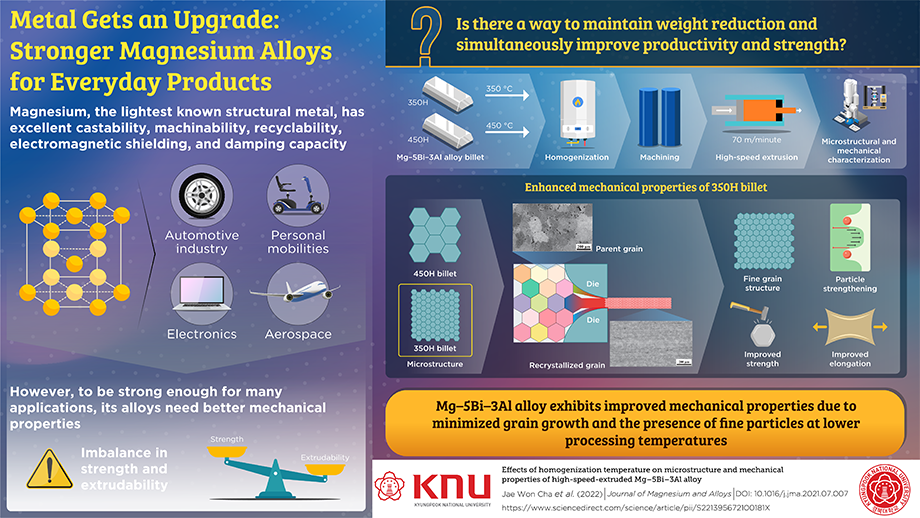Effects of homogenization temperature on microstructure and mechanical properties of high-speed
- Date
- 2024/07/16
- Writer
- 사이트매니저
- Hit
- 13
Image title: A Faster Route to Stronger Magnesium for Everyday Products
Image caption: The new BA53 magnesium alloy promises enhanced strength and productivity for diverse industrial applications.
Image credit: Sung Hyuk Park from Kyungpook National University
License type: Original Content
Usage restrictions: Cannot be reused without permission.
Amidst the climate change crisis and rising global warming, governments globally are tightening automobile emission regulations to achieve a reduction in carbon emissions. As a result, the automobile industry has turned its focus to making lightweight vehicles, including lighter cars, railways, airplanes, drones, urban air mobility, and bicycles. Magnesium, being the lightest known structural metal, is promising in this regard, and its alloys have attracted significant attention for developing lighter automobile components. Furthermore, magnesium has excellent castability, machinability, recyclability, electromagnetic shielding, and damping capacity.
Extrusion is a crucial metal-shaping process used to form magnesium products such as rods, tubes, and beams, enhancing their strength and making them lighter. Before extrusion, the metal undergoes a process called homogenization, where it is heated evenly to mix its components and remove any uneven parts that form during cooling. This prepares the metal for shaping, ensuring it is easier to work with and improves its overall quality. However, the slow production speeds and high costs associated with traditional magnesium alloys have been significant challenges in their widespread use. Notably, commercial magnesium has Mg17Al12 and Mg2Zn phases, whose melting during high-temperature, high-speed extrusion leads to the formation of hot cracks.
In this regard, a group of researchers from the Republic of Korea, led by Professor Sung Hyuk Park from the Department of Materials Science and Metallurgical Engineering at Kyungpook National University, recently addressed these challenges by creating a new high-speed-extruded magnesium alloy called Mg–5Bi–3Al or BA53. Their study was made available online on 13 August 2021 and published in Volume 10, Issue 10 of the Journal of Magnesium and Alloys in October 2022.
The present study revealed that setting the homogenization temperature to 350 °C made it much easier to shape the BA53 alloy. This created a higher concentration of fine particles within the grains, preventing them from growing too large during the process. Consequently, the alloy showed excellent mechanical properties, such as greater tensile strength and flexibility, which are essential for durability and performance in various applications. The researchers attributed these properties to stronger grain-boundary hardening, particle hardening, and strain hardening effects. However, when the temperature was set to 450 °C, the alloy developed a rougher microstructure with larger grain sizes. Although the alloy still retained good mechanical properties, its tensile strength and flexibility were not as impressive as those seen at 350 °C. This contrast underscores the crucial role of choosing the right homogenization temperature to maximize the BA53 alloy's performance.
Prof. Park explains, "Our study shows that the choice of homogenization temperature can greatly impact the microstructure and mechanical properties of the BA53 alloy during high-speed extrusion. This finding opens up new possibilities for using magnesium alloys in applications where strength and productivity are key."
Moreover, the improved extrudability and mechanical properties of the BA53 alloy at lower homogenization temperatures (350 °C) can contribute to sustainability efforts in manufacturing. By reducing the energy required for processing and minimizing material waste, this advancement aligns with the industry's goals for sustainable practices. Prof. Park concludes, "Being able to extrude BA53 at speeds as high as 69 m/min without compromising its mechanical properties is a game-changer for industries needing lightweight, high-strength materials. This study provides a sustainable way to improve the performance of magnesium alloys in structural applications."
Reference
Title of original paper: | Effects of homogenization temperature on microstructure and mechanical properties of high-speed-extruded Mg–5Bi–3Al alloy |
Journal: | Journal of Magnesium and Alloys |
DOI: |
About Kyungpook National University
Kyungpook National University (KNU) is a national university located in Daegu, South Korea.
Founded in 1946, it is committed to becoming a leading global university based on its proud and lasting tradition of truth, pride, and service. As a comprehensive national university representing the regions of Daegu and Gyeongbuk Province, KNU has been striving to lead Korea’s national and international development by fostering talented graduates who can serve as global community leaders.
Website: https://en.knu.ac.kr/main/main.htm
About Prof. In-Jung Lee
Dr. In-Jung Lee is a senior Professor in the Department of Applied Biosciences at Kyungpook National University, South Korea. He earned his Ph.D. from Texas A&M University, USA. Prof. Lee researches plant physiology, and his team focuses on pioneering approaches to understand plant growth regulation, phytohormonal signaling, and plant-microbe interactions, particularly under stressful conditions. Professor Lee's research delves into the intricate roles of plant hormones in growth and development, especially in response to changing environmental factors. A key focus of his work is investigating how microorganisms can mitigate environmental stressors.
About Prof. Abdul Latif Khan
Dr. Abdul Latif Khan is an Assistant Professor of Plant Physiology and Genomics in the Department of Engineering Technology at the University of Houston, USA. He completed his postdoctoral training and earned a Ph.D. from Kyungpook National University, South Korea. Before coming to the University of Houston, he was an Assistant Professor at the University of Nizwa, Oman, where he gained experience with plant-microbe interactions and genomics. His group is developing approaches to studying plant-microbe interactions, gas exchange, and genomics of plants under stressful conditions.
About Prof. Ahmed Al-Harrasi
Dr. Al-Harrasi is a Professor at the Natural & Medical Sciences Research Center, University of Nizwa, Oman. He has obtained an MSc. and Ph.D. in Chemistry from the Free University of Berlin. He received the Fulbright award for postdoctoral research in Chemistry at Cornell University. His research group at the University of Nizwa, Oman, extensively works in plant and soil chemistry.











